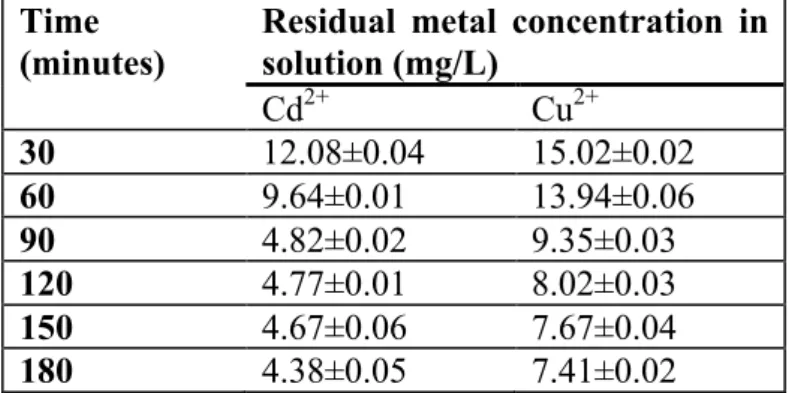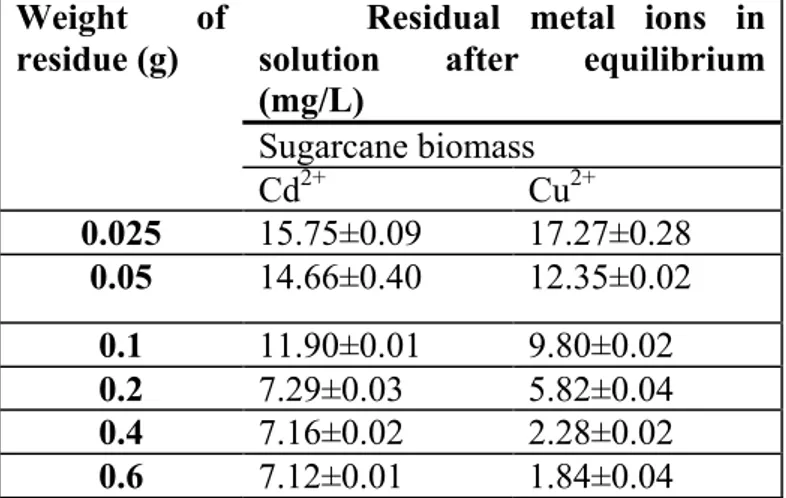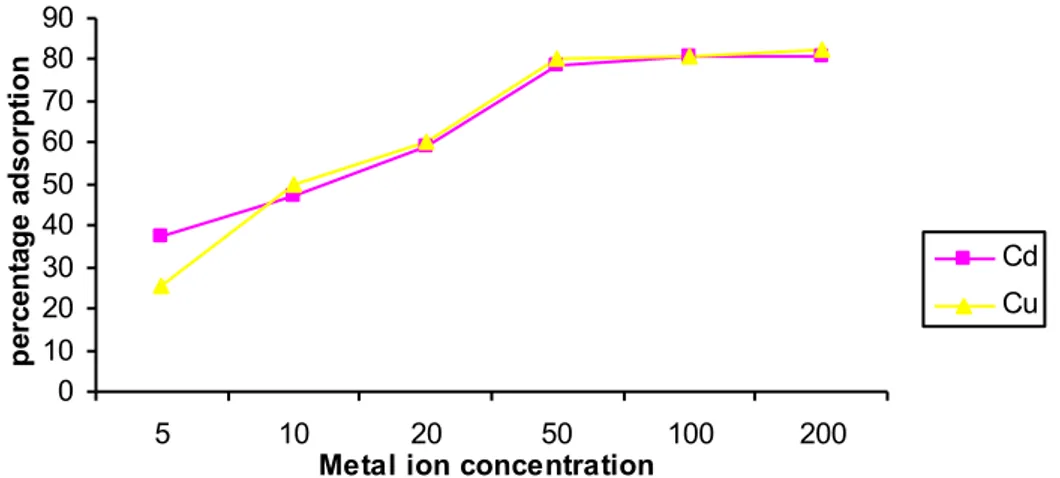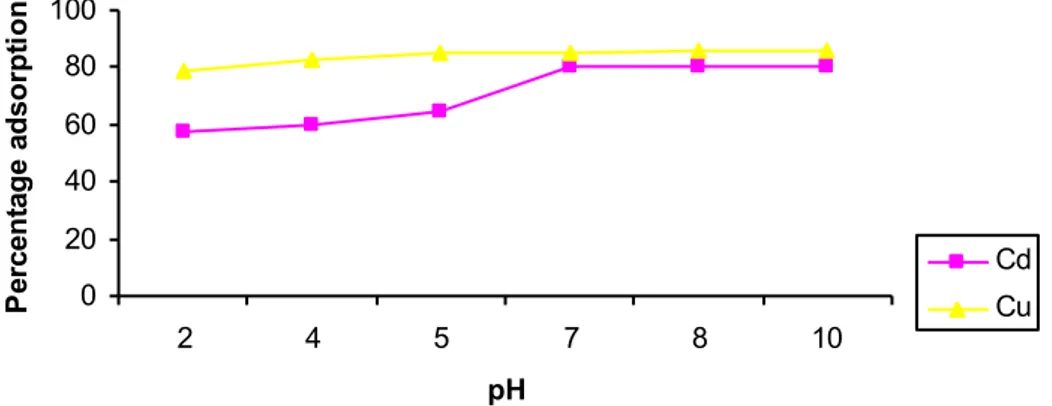SORPTION OF HEAVY METAL IONS (Cu
2+and
Cd
2+) FROM SIMULATED AND INDUSTRIAL
WASTEWATERS USING SUGARCANE
BIOMASS
Opeolu, B.O.
Fatoki, O.S
.Department of Chemistry, Faculty of Applied Sciences
Cape Peninsula University of Technology
Cape Town, South Africa
ABSTRACT
The widespread use of heavy metals in different manufacturing processes has resulted in their presence in the air, soil and aquatic ecosystems. Many manufacturing processes release their effluents into nearby streams and rivers due to non-availability of waste treatment technologies in the developing world. Industrialization has therefore been reported to be a major anthropogenic source of these elements and their compounds waterbodies. Conventional methods that are currently being used in the developed world (such as chemical precipitation, ultra-filtration, reverse osmosis, etc) are expensive and so, unaffordable to small-scale businesses prevalent in developing economies. The need for alternative, cheaper and available technologies therefore, cannot be over-emphasized. This study attempted to remove heavy metals (Cu2+ and Cd2+) from simulated and industrial (paint and textile) wastewaters using sugarcane biomass. A synthetic resin (Chelex) was used as control. Batch sorption experiments were conducted to assess the influence of contact time, adsorbent dose, adsorbate concentration, pH, agitation speed, temperature and particle size. Increases in the parameters (except particle size) gave corresponding increases in percentage adsorption of both metals. Optimal temperature for adsorption was achieved at 50oC above which adsorption declined considerably. Experimental data for Cu2+ and Cd2+ fitted well into freundlich and langmuir isotherms. In textile effluent, 100% adsorption was achieved for both metals using sugarcane biomass in contrast to 89% and 91% for Cu2+ and Cd2+ respectively in chelex, a synthetic resin. Similarly, adsorption was 100% for both metals using the biosorbent. Sugarcane biomass may therefore be utilized for water and wastewater remediation in the developing world. Its biodegradability gives comparative advantage over alternative synthetic and expensive resins since its disposal will be more environmentally friendly.
KEYWORDS
Copper; cadmium; sugarcane biomass; wastewaters; remediation.
1. INTRODUCTION
Increasing shortage of freshwater resources due to global climatic changes poses greater demand on water supplies. Water needs for domestic, industrial and recreational purposes however increases by day worldwide. The need for remediation and reuse of large volumes of industrial wastewaters being generated globally therefore becomes imperative. Pollution of
the various environmental compartments (water, soil, and air) is an important consequence of industrial processes and human activity. Metals are naturally distributed in the environment both by geological and biological cycles. The metal contamination of the environment reflects both natural sources and the contribution from industrial activity [1]. Heavy metals released by a number of industrial processes are some of the major pollutants in soil and water resources [2]. Main industrial sources of pollution include electroplating, battery and mining industries discharging a variety of toxic metals such as lead, copper, nickel, zinc and cadmium [3, 4]. Heavy metals are toxic and environmentally harmful substances; they have accumulating characteristics in nature as they cannot be degraded. Accumulation of these metals in human body causes brain, skin, pancreas and heart diseases [4, 5]. Heavy metal pollution is therefore, a serious problem and this has led to the development of new and improved methods for treating wastewaters [6].
Conventional methods for removal from waters include electrodialysis, chemical precipitation, ultrafiltration, reverse osmosis,etc. [3,7,8]. Technical and economic constraints often pose limitations on the industrial applicability of these methods especially in developing countries [6, 9, 10]. Adsorption, ion exchange, chemical settling and reverse osmosis are the most frequently preferred methods. Among them, adsorption receives considerable interest with high efficiency in heavy metal removal [4]. Different materials have been utilized for heavy metals removal from wastewaters. They include bacteria [1], algae [3], clay materials [4, 11, 12], chitosan [13] and animal bi-products [14]. Cellulosic materials that have been used include wheat bran [2], pine sawdust [5], sour orange [6], sugar beet pulp [15] and maize cob [16].
Sugar cane is a highly versatile plant, and can be grown successfully under a wide range of conditions. The by–products of sugar manufacture (molasses, bagasse and filter mud) are used in many ways including food as well as the basic raw material for burgeoning the sucro-chemical industry [17]. In most developing countries of Africa, sugarcane fibre is usually discarded and presently, there is no known use of this waste material in this part of the globe. The objective of this work therefore is to investigate the adsorption potential of sugarcane biomass for heavy metal ions (Cu2+ and Cd2+) removal from aqueous matrices, its desorption and re-use potentials.
2. MATERIALS AND METHODS
2.1 Reagents, biomass preparation, effluent collection and instrumentation
Deionized water was used to prepare all solutions and all chemicals used were of analytical grade (Merck, Germany). The laboratory glassware was kept overnight in a 5% (v/v) nitric acid solution. Afterwards, it was rinsed thoroughly with deionized water and dried. Working solutions in the range of 5 – 200 mg/L were prepared daily by diluting corresponding stock solutions (1000 mg/L of Cu2+ or Cd2+). The synthetic resin used was Chelex (Bio-Rad, France) France; batch samples of sugar cane fibre were collected as waste materials from dumps. The fibres were cut into smaller sizes, thoroughly washed, first with tap water and then, with distilled deionized water and then oven-dried at 90oC for 24 h. The dried samples were then ground using a wooden mortar, sieved using 100, 200, 500 and 2000 mesh screens. These particle size fractions of the biomass were washed twice with 0.01 M HCl to remove any metals or debris that might be in the biomass prior to experimental metal ion exposure. The acid washed biomass samples were again washed twice with distilled- deionized water to remove acid and then, oven-dried at 70oC for 48 h. This pretreated biomass was then stored in
Batch samples of paint and textile effluents were collected into clean plastic bottles from points of discharge at Ikeja Industrial Estate, Lagos – Nigeria. Effluents pH values were measured using a pH meter (Jenway Ltd., Dunmow Essex, England, model 3015). Metal ion concentrations were analysed using Alpha 4 Atomic Absorption Spectrophotometer (Chemtech Analytical, UK) with hollow cathode lamps. The operating conditions of the AAS instrument for metals’ ions analyses (copper and cadmium) were 3.0, 0.5, 324.7 and 3.0, 0.5, 228.8 for HC lamp current (mA), Slit width (nm) and Wavelength (nm) respectively.
2.2 Experimental run Adsorption Experiments
Equilibrium conditions of adsorbents weight (capacity studies), contact time (kinetics), pH and metals’ concentrations (equilibrium isotherm), temperature, particle size and agitation speed were studied using respective metal standard solutions and industrial (textile and paint) effluents [16].
Kinetic Studies
Kinetic parameters for the adsorption process were studied on batch adsorption of 100 mg/L solutions at 320C. Six sets of a mixture of sugarcane biomass (0.4 g) in 25 mL of 100 mg/L metal ion in 100 mL conical flasks were allowed to stand at different time intervals of 30, 60, 90, 120, 150 and 180 min respectively for adsorption to take place. The mixtures were then filtered to separate the adsorbent and the filtrate to allow for analysis of residual metal ions.
Capacity studies
Different weights of each of the adsorbents (sugarcane biomass and chelex) in the range of 0.025 g and 0.6 g in 25 ml solution were used to remove metals from 100 mg/L standard solutions. A 25 ml aliquot each of the metals’solutions was accurately measured into 100 ml conical flask and the adsorbent added to the flask; a contact time of 2 h was maintained for all the experiments. After 2 h contact time, the mixture was filtered through Whatman No 1 Filter paper (medium flow rate and porosity with particle retention of 11µm) and the filtrate analysed for residual metalby AAS.
Effect of pH on adsorption capacity
The pH of 100 mg/L metal solution prepared from 1000 mg/L stock solution was adjusted to desired value and kept constant with the addition of either 0.1 M NaOH or 0.1 M HCl. The pH values investigated were 2, 4, 5, 7, 8 and 10. Sugarcane biomass (0.4 g) aliquot was weighed and added to 25 ml of 100 mg/L metal solution at the desired pH and left for 2 h. The mixture was then filtered and the filtrate analyzed for metal ion concentration.
Effect of concentration on adsorption
Metals standard solutions with concentration range of 5 mg/L and 200 mg/L were prepared from the stock solution. Adsorbent weight of 0.4 g in 25 ml solution was also used for adsorption isotherm studies with a contact period of 2 h (earlier established as equilibrium time or adsorption) after which the mixture was filtered for metals analyses.
Effect of shaking speeds
A 0.4 g aliquot of f sugarcane biomass was weighed into 25 ml solution of 100 mg/L metal ion in a 100 ml conical flask. The mixtures were shaken in an orbital shaker (Edmund Buhler, GmbH & Co., Germany) at speeds in the range of 50 rpm and 300 rpm. After 30 min, the
mixtures were filtered using Whatman No 1 filter paper and filtrates analyzed for residual metal content.
Effect of Temperature
Metal ion solutions were equilibrated by rocking a mixture of 0.4 g sugarcane biomass and 25ml of 100 mg/L for 30 min at 250 rpm at different temperatures (30oC, 40oC, 50oC, 60oC,
70oC and 80oC in a water bath (Techne Cambridge Ltd, Duxford Cambridge, England). These were centrifuged immediately at 2500 rpm for 5 min and the supernatant decanted. The supernatants were then analyzed for metal concentrations using AAS.
Effect of Particle Size
Zero point four grammes (0.4 g) of 100, 200, 500 and 2000 mesh adsorbents were weighed and transferred to separate tubes; 25 ml of 100 mg/mL metal solution was then added to each tube and equilibrated by rocking for 30 min at 250 rpm. The mixture was centrifuged at 2500 rpm for 5 min and the supernatant used for the analysis of residual metal ions.
Adsorption studies on effluents
Textile and paint effluents (pH values 3.93 and.4.56 respectively at 30oC at the point of discharge) were used for the experiment. For each effluent, 0.4 g each of the adsorbents (sugarcane biomass and chelex) were added to 25 ml of the effluent and left standing for 2 h. At the expiration of 2 h, the mixtures were filtered and the filtrates analyzed for metal ions.
3. RESULTS AND DISCUSSION
Table 1: Equilibrium concentration of metals onto sugarcane biomass at different time intervals (Mean± SD) n=3
Time (minutes)
Residual metal concentration in solution (mg/L) Cd2+ Cu2+ 30 12.08±0.04 15.02±0.02 60 9.64±0.01 13.94±0.06 90 4.82±0.02 9.35±0.03 120 4.77±0.01 8.02±0.03 150 4.67±0.06 7.67±0.04 180 4.38±0.05 7.41±0.02
Effects of contact time on adsorption of metals are presented in Table 1. Results obtained in this study showed that at pH 5, optimal adsorption was achieved in 2 h for Cd2+ and 2 h and
30 min for Cu2+. Subsequent adsorption experiments were therefore carried out at the optimal contact time for the respective metals unless otherwise stated. The result is consistent with those of Altundogan et al. [15] who reported 2-3 h equilibrium time for Cu2+ sorption when acid and alkaline modified sugar beet pulp was used as adsorbent. Adsorption rate constant (Kad), which was calculated using Lagergren’s equation (which is the most widely used
sorption equation), followed a second order mechanism for sugarcane biomass. Values were comparable to those of coirpith carbon reported by Kadirvelu and Namasivayam [19], Ilhan et
Adsorption capacity of sugarcane biomass is presented in Table 2. The results obtained for capacity studies established that the amount of adsorbent (sugarcane biomass) used is an important factor in metal removal from solution Adsorption of both metals increased with increasing biomass weight. Optimum adsorption was achieved with 0.4 g sugarcane biomass for both metals. Sugarcane biomass contained cellulose as a major component in its chemical structure. Shukla and Pai [21] reported that cellulose has a two-phase structure, the crystalline compact structure that cannot be penetrated and the amorphous open structure composed of surfaces, external as well as the internal surfaces, which allow the adsorption of heavy metal cations. The pore size of a material plays an important role in deciding the level of penetration of a chemical entity in the amorphous region followed by it adsorption.
Effects of metal concentration on adsorption are presented in Figure 1. Obtained trend is consistent with previous results in the literatures [20, 22-28].These authors all reported increased adsorption with increasing metal ion concentration. Freundlich and Langmuir isotherm models were used to adjust experimental data (Table 3).
Table 2: Equilibrium capacity of sugarcane biomass for metals’ removal (Mean ±SD) n=3
Weight of
residue (g)
Residual metal ions in solution after equilibrium (mg/L) Sugarcane biomass Cd2+ Cu2+ 0.025 15.75±0.09 17.27±0.28 0.05 14.66±0.40 12.35±0.02 0.1 11.90±0.01 9.80±0.02 0.2 7.29±0.03 5.82±0.04 0.4 7.16±0.02 2.28±0.02 0.6 7.12±0.01 1.84±0.04
Figure 1. Influence of metal ion concentration on percentage adsorption by sugarcane biomass. 0 10 20 30 40 50 60 70 80 90 5 10 20 50 100 200
Metal ion concentration
pe rc ent age a ds orpt ion Cd Cu
Table 3: Isotherm parameters for metals’ adsorption on to sugarcane biomass
Metal Langmuir Freundlich
Xm (mg/g) K R2 Kf n R2
Cd2+ 48.91 0.032 0.992 0.70 9.82 1.000
Cu2+ 35.68 0.029 0.998 0.08 9.72 0.999
The Freundlich model considers the existence of a multilayered structure [26]. Values of Kf
and n, determined from the slope of Freundlich plots were about unity, and this suggests favourable adsorption for the biomass. This agrees with Kadirvelu and Namasivayam [29] who showed that n-values (sorption intensity indicator) between 1 and 10 represent beneficial adsorption. Coefficients of determination were found to be highly positively correlated to sorption ability of residues. Significant adsorption may therefore take place even at high metal concentrations.
In the present study, adsorption was found to be dependent on the pH of adsorption (Figure 2). There was a steady increase in adsorption with increasing pH; the decrease in adsorption at low pH values is due to an increase in competition for adsorption sites by H+. Furthermore,
adsorption was reported to depend on factors other than pH which include flow rate, resident time, effects of dissolution of some other materials from adsorbents, amongst others. This may explain the continued increase in adsorption of metals by biomass after pH 6 when precipitation of metals is expected to set in. Metals removal by biomass occurs by a combination of physio-sorption and chemisorption. Physio-sorption occurs by trapping of metal ions into the pores of adsorbents while chemisorption is believed to occur at the carboxylic binding sites. However, the exact mechanism of chemisorption of metals onto biomass is not fully understood at very acidic and alkaline pH values [30].
Percentage adsorption was greatly enhanced by shaking and the equilibrium value was attained at 30 minutes (Results not presented). Percentage adsorption of metal ions was
enhanced by shaking both for standard solution and the effluents. In textile effluent, 100% adsorption was achieved in shaken experiments for both metals; adsorption by sugarcane biomass was significantly enhanced by shaking (p=0.05). Also in paint effluent, sugarcane biomass had 100% adsorption in shaken experiment.
Figure 2. Effect of pH on percentage adsorption of metals by sugarcane biomass
0 20 40 60 80 100 2 4 5 7 8 10 pH P er ce nt age a ds orpt ion Cd Cu
Figure 3. Influence of temperatue on percentge adsorption of metal ions by sugarcane biomass.
0 20 40 60 80 100 30 40 50 60 70 80 Temperature (oC) P er ce nt age a ds orpt ion Cd Cu
Optimal temperature for adsorption for both metals was 50oC above which adsorption reduced considerably for Cd2+. High temperatures tend to decrease the boundary layer thickness; the metal ions therefore had increased tendency to escape from the biomass surface to the solution phase. The decreased adsorption with increasing temperature also suggests weak adsorption interaction between biomass surface and the metal ion, which supports physiosorption [31].
Regression analysis showed that particle density and porosity of adsorbents are important parameters for good adsorption. Particle density and porosity are negatively correlated to percentage adsorption in textile effluent and the former in particular is significant at 95% confidence level. There was enhanced metal adsorption with decreasing particle sizes (Results
not presented).Rate of removal of metals from aqueous solutions has been reported to be particle-diffusion controlled (Kp is the rate coefficient for particle diffusion control corresponding to the particle size of the adsorbent) [32]. This seems to be due to increase in surface area and exposure of functional groups responsible for metal binding. Results of comparative metals’ removal from wastewaters using sugarcane biomass and chelex are presented in Table 4. Under agitation, sugarcane biomass had 100% adsorption for both metals in the two effluent types (Results not presented).
Table 4. Percentage adsorption of metals in textile and paint effluents.
Effluent Cd2+ Cu2+
Biomass Chelex Biomass Chelex
Textile 94.28 57.10 87.52 61.45
Paint 98.67 53.49 98.89 55.26
4. CONCLUSION
Effects of adsorbent weight, metal concentration, contact time, pH, agitation, temperature, particle size were assessed to determine equilibrium conditions for adsorption. Percentage adsorption of metals was considerable (over 90%) for both metals both textile and paint effluents; comparative assessment of shaken and unshaken experiments revealed that shaking enhanced percentage adsorption for both sugarcane biomass and chelex. The biomass is a better adsorbent for metals since it has greater potential to remove metals from effluents. It also has an added advantage of being biodegradable; hence, disposal will be relatively easier
5. ACKNOWLEDGEMENT
The financial support of the International Foundation for Science (IFS), Sweden for (grant
number W/4264-1) is acknowledged.
REFERENCES
[1] Dogru, M., Gul-Guven, R., Erdogan, S., 2007. The use of Bacillus subtilis immobilized on Amberlite XAD-4 as a new biosorbent in trace metal determination. J. Hazard.
Mater. 149, 166–173.
[2] Nouri, L., Ghodbane, J., Handaoni, O., Chiha, M., 2007. Batch sorption dynamics and equilibrium for the removal of cadmium ions from aqueous phase using wheat bran. J.
Hazard. Mater. 149, 115-125.
[3] Ahmady-Asbchin, S., Andres, Y., Gerente, C., Cloirec, P.L., 2008. Biosorption of Cu(II) from aqueous solution by Fucus serrantus: Surface characterization and sorption mechanisms. Biores. Technol. 99, 6150-6155.
[4] Veli, S., Alyuz, B., 2007. Adsorption of copper and zinc from aqueous solutionsby using natural clay. J. Hazard. Mater. 149, 226-233.
[5] Uysal, M., Ar, I., 2007. Removal of Cr(VI) from industrial wastewaters by adsorption Part I: Determination of optimum conditions. J. Hazard. Mater. 149, 482-491.
[6] Khormaei, M., Nasernejad, B., Edrisi, M., Eslam zadech, T., 2007. Copper biosorption from aqueous solutions by sour orange residues. J. Hazard. Mater. 149, 269-274.
[7] Stirk, W. A., Staden, J. V., 2000. Removal of heavy metals from solution using dried Brown seaweed material. Botanica Marina. 43, 467-473.
[8] Peric, J., Trgo, M., Medvidovic, N.V., 2004. Removal of zinc, copper and lead by natural zeolite- a comparison of adsorption isotherms. Water Res. 38, 1893-1899. [9] Horsfall, M., Spiff, A. I., 2004. Studies on the Effect of pH on the Sorption of Pb2+ and
Cd2+ ions from aqueous Solutions by Caladium bicolor (Wild cocoyam) Biomass. Elect. J. Biotechnol. 7(3), December 15 Issue.
[10] Krishnani, K.K., Meng, X., Christodoulatos, C., Boddu, V.M., 2008. Biosorption mechanism of nine different heavy metals onto biomatrix from rice husk. J. Haz.
Mater. 153, 1222-1234.
[11] Sari, A., Tuzen, M., Citak, D., Soylak, M., 2007. Equilibrium, kinetic and thermodynamic studies of adsorption of Pb(II) from aqueous solution onto Turkish kaolinite clay. J. Haz. Mater. 149, 283-291.
[12] Chen, H., Zhao, Y., Wang, A., 2007. Removal of Cu(II) from aqueous solution by adsorption onto acid-activated palygorskite. J. Haz. Mater. 149, 346-354.
[13] Laus, R., Geremias, R., Vasconcelos, H.L., Laranjeira, M.C.M., Favere, V.T., 2007. Reduction of acidity and removal of metal ions from coal mining effluents using chitosan microspheres. J. Haz. Mater. 149, 471-474.
[14] Lu, S., Gibb, S.W., Cochrane, E., 2007. Effective removal of zinc ions from aqueous solutions using crab carapace biosorbent. J. Haz. Mater. 149, 208-217.
[15] Altundogan, H.S., Arslan, N.E., Tumen, F., 2007. Copper removal from aqueous solutions by sugar beet pulp treated by NaOH and citric acid. J. Haz. Mater. 149, 432-439.
[16] Opeolu, B.O., Bamgbose, O., Arowolo, T.A., Adetunji, M.T., 2009. Utilization of maize cob (Zea mays) as adsorbent for lead (II) removal from aqueous solutions and industrial effluents. Afr. J. Biotechnol. 8 (8), 1567-1573.
[17] Blackburn, F., 1991. The origin of sugarcane. Sugar cane. Longman, London pp 1-330.
[18] Khan, M.N., Wahab, M.F., 2007. Characterization of chemically modified corncobs and its application in the removal of metal ions from aqueous solution , J. Haz.
Mater., 141, 237-244.
[19] Kadirvelu, K., Namasivayam, C., 2003. Activated carbon from coconut coirpith as metal adsorbent: adsorption of Cd(II) from aqueous solution. Adv. Environ. Res. 7(2), 471-478.
[20] Ilhan, S., Nourbakhsh, M. N., Kilicarslan, S., Ozdag, H., 2004. Removal of Chromium,Lead and Copper ions from industrial wastewaters by Staphylococcus
saprophyticus. Turk. Elect. J. Biotechnol. 2, 50-57.
[21] Shukla, S.R., Pai, R. S., 2005. Removal of Pb (II) from solution using cellulose containing materials. J. Chem. Technol. Biotechnol. 80, 176-183.
[22] Al-Asheh, S., Duvnjak, Z., 1999. Sorption of heavy metals by Canola meal. Water,
Air, Soil Pollut. 114, 251-276.
[23] Tsekova, K., Petrov, G., 2002. Removal of heavy metals from aqueous solution using Rhizopus delemar mycelia in free and polyurethane-bound form. Z.
Naturforsch. 57c, 629-633.
[24] Al-subu, M. M., 2002. The Interaction effects of cypress (Cupressus sempervirens), Cinchona (Eucalyptus longifolia) and pine (Pinus halepensis) leaves on their efficiencies for lead removal from aqueus solutions. Adv. Environ. Res. 6(4), 569-576.
[25] Kok, K. H., Karim, M. I. A., Ariff, A., 2001. Bioremoval of Cadmium, Lead and Zinc Using Non-living bioass of Aspergillus flavus. Pakistan J. Biological Sci. 4(7), 849-853.
[26] Cossich, E. S., Tavares, C.R.G., Ravagnani, T.M.K., 2002. Biosorption of chromium (III) by Sargassum sp biomass. Elect. J. Biotechnol. 5(2), August 15 Issue.
[27] Vijayaraghavan, K., Jegan, J. R., Palanivelu, K., Velan, M., 2004. Copper removal from Aqueous solution by marine green algae (Ulva reticulata). Elect. J. Biotechnol. 7(1), Issue of April 15.
[28] Klimmek, S., Stan, H. J., Wilke, A., Bunke, G., Buchholz, R., 2001. Comparative analysis of the biosorption of Cadmium, Lead, Nickel and Zinc by Algae. Environ.
Sci. Technol. 35, 4283-4288.
[29] Kadirvelu, K., Namasivayam, C., 2000. Agricultural by-products as metal adsorbents: Sorption of Lead (II) from aqueous solutions onto coirpith carbon. Environ. Technol. 21, 1091-1097.
[30] Kar, P., Misra, M., 2004. Use of Keratin Fibre for separation of heavy metals from water. J. Chem. Technol. Biotechnol. 79, 1313-1319.
[31] Horsfall, M., Spiff, A. I., 2005. Effect of temperature on the sorption of Pb2+ and Cd2+ From aqueous solution by Caladium bicolor (Wild cocoyam) biomass. Elect. J.
Biotechnol. 8(2), Issue of August 15.
[32] Okiemen, F. E., Okundia, E. U., Ogbeifun, D. E., 1991. Sorption of Cadmium and Lead Ions on modified groundnut (Arachis hypogea) husk. J. Chem. Technol.
Biotechnol. 51, 97-103.




